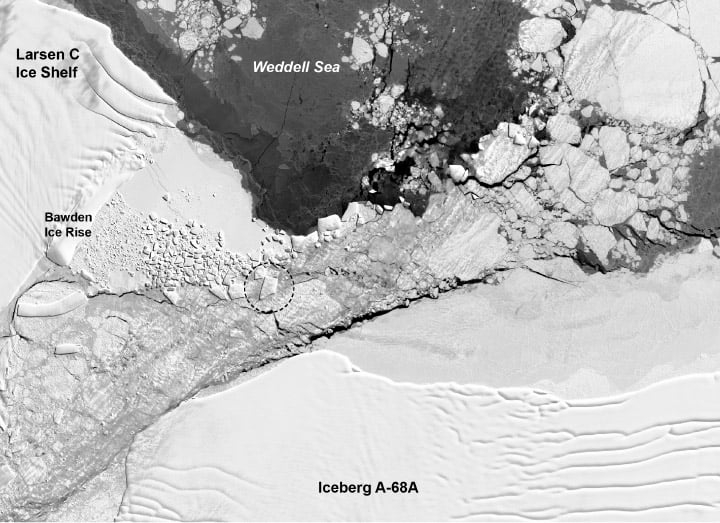That stunning
rectangular iceberg
that was photographed in mid-October by NASA scientist Jeremy Harbeck had a much more harrowing journey than we thought. Scientists looked back through satellite images to retrace the 'berg's journey. They found that it calved from the Larsen C Ice Shelf in November 2017.
In Universe Today's
original article
on the rectangular iceberg, we reported that it had recently calved from the huge
iceberg A-68
, which itself came from the
Larsen C Ice Shelf
. This made sense because nobody thought that those square edges could've survived for so long without being disfigured.
But as it turns out, the square-cornered icebergs didn't come from A-68, but directly from the Larsen C Ice Shelf. That means it had a much longer, much more hazardous journey than thought. Scientists went back over satellite data from the USGS's
Landsat 8
and the European Space Agency's
Sentinel-1
and traced the 'berg's origins.
What they found was that after the enormous A-68 iceberg calved from the Larsen C Ice Shelf, the rectangular iceberg broke off from the newly-exposed edge of Larsen. The image below, from Steph Lhermitte of the Delft University of Technology, shows what happened.
https://gfycat.com/GleefulObviousKitten
After it broke off from the Larsen Shelf, it began moving northward, through the new channel of water between A-68 and the Larsen. It's amazing it survived that part of its journey with its rectangular shape intact. The are is full of other, smaller bergs, not to mention A-68 and the Larsen Shelf.
The iceberg continued north and travelled through a narrow passage between A-68's northern tip and a rocky outcrop near the ice shelf known as Bawden Ice Rise. NASA/UMBC glaciologist Chris Shuman likens this zone to a nutcracker. The rectangular iceberg has a lot of cousins in the area. A-68 has repeatedly smashed against the Bawden Ice Rise, and caused pieces of ice to splinter into a collection of clean-cut geometric shapes. An area of geometric ice rubble is visible in the Landsat 8 image (below) from October 14, 2018, two days before the IceBridge flight that Harbeck first captured the images from.
[caption id="attachment_140464" align="alignnone" width="720"]
This Landsat-8 image from October 18th shows a field of geometric ice rubble including the rectangular iceberg, now a trapezoid. Image: Landsat-8[/caption]
The famous rectangular iceberg did not keep its remarkable shape through its journey. Repeated collisions broke it into smaller pieces, and in the image above it is a trapezoid. The trapezoidal berg is about 900 meters wide and 1500 meters long, and it's just another iceberg now, drifting north into warmer waters to die.
Sources:
- Earth Observatory Press Release: " Famous Rectangular Iceberg’s Rough Journey "
- Landsat-8 page
- Universe Today: Polar Researchers Spot Two Rectangular Icebergs
 Universe Today
Universe Today

